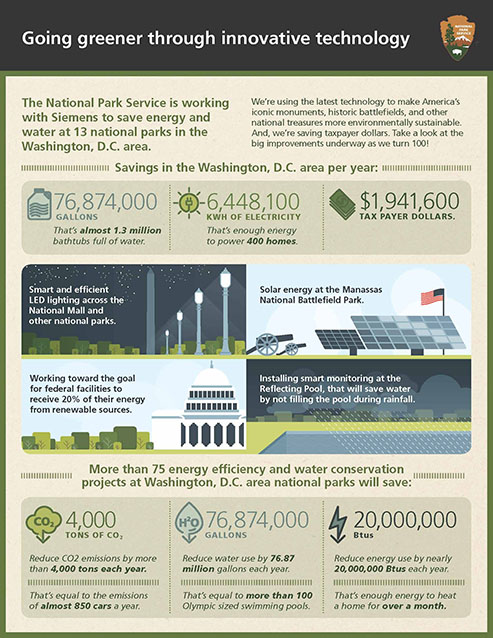We're adding energy- and water-saving improvements to save money! How can you do the same in your home?
How did they do it? National parks get greener
Did you know that the National Park Service is turning 100 this year? Since 1916, national parks have provided safe habitats for wild animals, places for kids to play, and fun ways to learn about nature and history. This year, national parks in your own backyard are completing lots of projects to save water and energy. What better way to say both Happy Birthday and Happy Earth Day than by following the National Park Service’s example and going green? Here are five tips for a more environmentally-friendly home:
-
Change a lightbulb: Have you ever seen the Washington Monument or Lincoln Memorial at night? These memorials look beautiful lit up in the dark, and now they’re energy-efficient too! New LED lights at the Washington Monument and Lincoln Memorial consume up to 80 percent less energy. Talk to your parents about replacing a regular lightbulb in your home with a more energy efficient compact fluorescent bulb, which uses a quarter of the energy.
-
Use less water: If your parents have ever asked you to water the lawn, you know that it can be easy to go overboard and soak the whole yard! The National Park Service has installed new sprinklers on the Ellipse, the south side of the White House. These smart sprinklers only turn on when the grass needs water. You can use less water in your home, too, by making simple changes in your daily routine. For example, turning off the tap when you brush your teeth can save up to 200 gallons of water a month. Baths use up to 70 gallons of water, so try taking a quick shower instead.
-
Plant a tree: The National Park Service is planting 1,000 trees throughout D.C. this year! Trees provide shelter for animals and improve our air quality by producing the oxygen you breathe. Talk to your parents about planting a tree in your own backyard, or start smaller by growing your own house plant.
-
Turn off lights and electronic devices: Did you know that solar panels at Manassas Battlefield Park in Virginia will soon provide enough energy to help power the park’s headquarters? Solar panels work by converting light from the sun’s rays into electrical energy. There are plenty of ways you can save energy in your home, too. Turn off the TV and computer when you’re not using them, unplug chargers when they’re not needed, and remember to always turn off the lights when you leave a room.
-
Clean up a park: As kids, you are the next generation of stewards of our national parks, which means that you are in charge of preserving America’s natural resources. That’s a big responsibility, but it doesn’t have to be scary. You can start by calling your local park to see if they need volunteers to help clean up trash or remove weeds. You can even help without leaving home! Make sure you recycle your plastic bags and water bottles so they don't end up polluting our parks.

NPS/Siemens
Infographic Information
Going greener through innovative technology.
The National Park Service is working with Siemens to save energy and water at 13 national parks in the Washington, D.C. area.
We're using the latest technology to make America's iconic monuments, historic battlefields, and other national treasures more environmentally sustainable. And, we're saving taxpayer dollars. Take a look at the big improvements underway as we turn 100!
Savings in the Washington, D.C. area per year:
- 76,874,000 Gallons - That's almost 1.3 million bathtubs full of water.
- 6,448,100 KWH of Electricity - That's enough energy to power 400 homes.
- $1,941,600 Tax Payer Dollars
Smart and efficient LED lighting across the National Mall and other national parks. Solar energy at the Manassas National Battlefield Park. Working toward the goal for federal facilities to receive 20% of their energy from renewable sources. Installing smart monitoring at the Reflecting Pool, that will save water by not filling the pool during rainfall.
More than 75 energy efficiency and water conservation projects at Washington, D.C. area national parks will save:
- 4,000 Tons of CO2 - Reduce CO2 emissions by more than 4,000 tons each year. That's equal to the emissions of almost 850 cars a year.
- 76,874,000 Gallons of H2O - Reduce water use by 76.87 million gallons each year. That's equal to more than 100 Olympic sized swimming pools.
- 20,000,000 Btus - Reduce energy use by nearly 20,000,000 Btus each year. That's enough energy to heat a home for over a month.
Tags
- antietam national battlefield
- catoctin mountain park
- chesapeake & ohio canal national historical park
- george washington memorial parkway
- harpers ferry national historical park
- manassas national battlefield park
- monocacy national battlefield
- national capital parks-east
- national mall and memorial parks
- the white house and president's park
- prince william forest park
- rock creek park
- washington monument
- wolf trap national park for the performing arts
- climate friendly practices
- espc
- antietam national battlefield
- catoctin mountain park
- chesapeake ohio canal national historical park
- george washington memorial parkway
- harpers ferry national historical park
- manassas national battlefield
- monocacy national battlefield
- national capital parks-east
- national mall and memorial parks
- presidents park
- rock creek park
- washington monument
- wolf trap national park for the performing arts
Last updated: October 3, 2016
